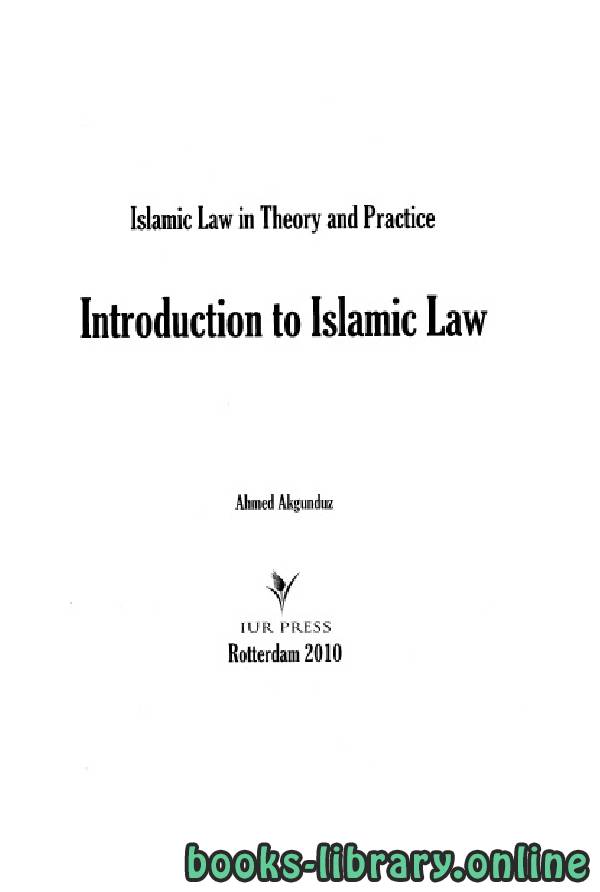📘 ❞ Introduction to Islamic Law (Islamic Law in Theory and Practice) part 1 ❝ كتاب ــ احمد أكغوندوز اصدار 2010
كتب القانون باللغة الأنجليزية English Law Books - 📖 كتاب ❞ Introduction to Islamic Law (Islamic Law in Theory and Practice) part 1 ❝ ــ احمد أكغوندوز 📖
█ _ احمد أكغوندوز 2010 حصريا كتاب ❞ Introduction to Islamic Law (Islamic in Theory and Practice) part 1 ❝ عن جميع الحقوق محفوظة للمؤلف 2025 1: : Book Description subject matter positive enactments are concerned that its study is indispensable order appreciate adequately the full range of possible legal phenomena Even two other representatives of a'sacred law' which historically geographically nearest itJewish law Canon law, sensibly different Both Jewish more uniform than Islamic The history it true, shows a break between sovereign state Dispersion, but spirit later parts Old Testament already very close Talmud Islam, on hand, represented radical breakaway from Arab paganism; result scrutiny, religious angle, subject was far uniform, comprising as did various components laws of Arabia numerous elements taken over peoples of conquered territories All this unified by being subjected same kind scrutiny impact varied greatly, being almost non existent some fields, others originating novel institutions This inner duality subjectmatter and religious norm additional outward variety of legal, ethical, ritual rules typical 'sacred law' buttressed cohesion community, reinforced pressure outside; its the direct expression feeling cohesion, leading rejection of all dissentients on the contrary, dominated dualism religion state, where not, contrast with Judaism, an alien power but political But their antagonism took forms; Christianity the struggle for power tightly organized ecclesiastical hierarchy, one political weapons Islam, never 'Church', Islamic supported organized power, consequently there developed real trial strength; there merely existed discordance between sacred and the reality actual practice regulations framed by the formed part, gap or less wide according place and time, now then point closed but continually reasserting itself شرح الكتاب : معنية بالموضوع والتشريعات الإيجابية أن الدراسة لا غنى عنها من أجل تقدير كامل بشكل كاف مجموعة الظواهر القانونية المحتملة حتى الممثلين الآخرين من قانون مقدس "تاريخيا وجغرافيا القانون اليهودي والقانون الكنسي مختلفان معقول كل القانون أكثر توحيدًا من الشريعة الاسلامية تاريخ الشريعة اليهودية صحيح يظهر قطيعة بين الدولة ذات السيادة وقانون التشتت لكن روح المسألة الأجزاء اللاحقة القديم إن العهد بالفعل قريب جدًا عهد التلمود دين الاسلام من ناحية أخرى يمثل انفصالا جذريا العرب الوثنية الإسلامية هي نتيجة فحص ديني زاوية لموضوع قانوني بعيد كل البعد التوحيد تشمل كما فعلت مختلف مكونات القوانين من شبه الجزيرة العربية والعديد العناصر التي تم الاستيلاء عليها الشعوب من الأراضي المحتلة هذا توحيده بالوجود يخضع لنفس النوع التدقيق الذي تباينت آثاره إلى حد كبير يكاد يكون غير موجود بعض المجالات وفي مجالات أخرى إنشاء مؤسسات جديدة هذه الازدواجية الداخلية للموضوع القانوني والقاعدة الدينية إضافة إلى التنوع الخارجي من القواعد والأخلاقية والطقسية نموذجية لـ "مقدس القانون' كان مدعوماً بتماسك المجتمع معززة بضغط الخارج ؛ قواعدها هي التعبير المباشر الشعور بالتماسك يؤدي الرفض من المعارضين والشريعة على على العكس ذلك تهيمن ثنائية الدين والدولة حيث تكون عكس قوة غريبة لكن التعبير السياسي نفس لكن هم اتخذت العداء أشكالًا مختلفة المسيحية كان الصراع السلطة السياسية جانب منظم بإحكام التسلسل الهرمي وكان أحد سياساتها أسلحة أما الإسلام فلم يكن أبدًا "كنيسة" لم تكن مدعومة قبل منظمة وبالتالي لم يتم تطوير تجربة حقيقية للقوة ؛ كان هناك مجرد تناقض بين المقدس و واقع الممارسة الفعلية صاغتها اللوائح شكلت جزءا فجوة واسعة ما حسب المكان والوقت الحين والآخر وشك الانغلاق ولكن باستمرار يعيد تأكيد نفسه كتب باللغة الأنجليزية English Books مجاناً PDF اونلاين section contains comprehensive varied set books language, where systems differ countries, an analysis their differences comparative In states civil legislative central body codifies unifies common systems, judges issue binding case through although sometimes may be overturned Supreme Court Historically, has affected secular matters still used societies Sharia based principles is basic system many including Iran Saudi Arabia The scope can divided into areas Public concerns government society, constitutional, administrative, organizational, criminal Private addresses disputes involving individuals organizations such contracts, property, damages misdemeanors commercial distinction stronger especially those have separate system administrative courts; contrary, private clear states يحتوي القسم علي مجموعة شاملة ومتنوعة الانجليزية حيث تختلف النظم البلدان مع تحليل اختلافاتها المقارن ولايات المدني تقوم هيئة تشريعية أو مركزية بتدوين وتوحيده أنظمة العام يصدر القضاة السوابق القضائية الملزمة خلال الرغم أنه الأحيان قد إسقاط محكمة عليا تاريخيا أثر الديني الأمور العلمانية ولا يزال يستخدم المجتمعات القائمة المبادئ كنظام أساسي العديد بما إيران والمملكة السعودية يمكن تقسيم نطاق مجالين يتعلق بالحكومة والمجتمع الدستوري والإداري والتنظيمي والجنائي يتناول الخاص المنازعات تنطوي الأفراد المنظمات مثل العقود والممتلكات والأضرار الجنح التجاري التمييز أقوى بلدان وخاصة تلك لديها نظام منفصل المحاكم الإدارية ؛على النقيض فإن الفجوة والخاص أقل وضوحًا

كتاب
Introduction to Islamic Law (Islamic Law in Theory and Practice) part 1
ــ احمد أكغوندوز
صدر 2010م
كتاب
Introduction to Islamic Law (Islamic Law in Theory and Practice) part 1
ــ احمد أكغوندوز
صدر 2010م- مساهمة من: احمد الراوي
( السبت 29 فبراير 2020 ( 4:35 مساءً )) - تبليغ عن سوء استخدام


: Book Description
subject-matter and positive enactments are concerned-that its
study is indispensable in order to appreciate adequately the full
range of possible legal phenomena. Even the two other representatives
of a'sacred law' which are historically and geographically
nearest to itJewish law and Canon law, are sensibly different.
Both Jewish law and Canon law are more uniform than
Islamic law. The history of Jewish law, it is true, shows a break
between the law of a sovereign state and that of the Dispersion,
but the spirit of the legal matter in the later parts of the Old
Testament is already very close to that of the Talmud. Islam,
on the other hand, represented a radical breakaway from Arab
paganism; Islamic law is the result of a scrutiny, from a religious
angle, of legal subject-matter which was far from uniform,
comprising as it did the various components of the laws
of Arabia and numerous elements taken over from the peoples
of the conquered territories. All this was unified by being
subjected to the same kind of scrutiny the impact of which varied
greatly, being almost non-existent in some fields, and in others
originating novel institutions. This inner duality of legal subjectmatter
and religious norm is additional to the outward variety
of legal, ethical, and ritual rules which is typical of a 'sacred
law'. Jewish law was buttressed by the cohesion of the community,
reinforced by pressure from outside; its rules are the
direct expression of this feeling of cohesion, leading to the rejection
of all dissentients. Canon and Islamic law, on the
contrary, are dominated by the dualism of religion and state,
where the state is not, in contrast with Judaism, an alien power
but the political expression of the same religion. But their
antagonism took on different forms; in Christianity it was the
struggle for political power on the part of a tightly organized
ecclesiastical hierarchy, and Canon law was one of its political
weapons. Islam, on the other hand, was never a 'Church',
Islamic law was never supported by an organized power,
consequently there never developed a real trial of strength;
there merely existed a discordance between the sacred Law and
the reality of actual practice of which the regulations framed by
the state formed part, a gap more or less wide according to place
and time, now and then on the point of being closed but continually
reasserting itself.
شرح الكتاب :
معنية بالموضوع والتشريعات الإيجابية - أن
الدراسة لا غنى عنها من أجل تقدير كامل بشكل كاف
مجموعة من الظواهر القانونية المحتملة. حتى الممثلين الآخرين
من قانون مقدس "تاريخيا وجغرافيا
القانون اليهودي والقانون الكنسي مختلفان بشكل معقول.
كل من القانون اليهودي والقانون الكنسي أكثر توحيدًا من
الشريعة الاسلامية. تاريخ الشريعة اليهودية ، صحيح ، يظهر قطيعة
بين قانون الدولة ذات السيادة وقانون التشتت ،
لكن روح المسألة القانونية في الأجزاء اللاحقة من القديم
إن العهد بالفعل قريب جدًا من عهد التلمود. دين الاسلام،
من ناحية أخرى ، يمثل انفصالا جذريا عن العرب
الوثنية. الشريعة الإسلامية هي نتيجة فحص ديني
زاوية ، لموضوع قانوني بعيد كل البعد عن التوحيد ،
تشمل كما فعلت مختلف مكونات القوانين
من شبه الجزيرة العربية والعديد من العناصر التي تم الاستيلاء عليها من الشعوب
من الأراضي المحتلة. كل هذا تم توحيده بالوجود
يخضع لنفس النوع من التدقيق الذي تباينت آثاره
إلى حد كبير ، يكاد يكون غير موجود في بعض المجالات ، وفي مجالات أخرى
إنشاء مؤسسات جديدة. هذه الازدواجية الداخلية للموضوع القانوني
والقاعدة الدينية هي إضافة إلى التنوع الخارجي
من القواعد القانونية والأخلاقية والطقسية التي هي نموذجية لـ "مقدس
القانون'. كان القانون اليهودي مدعوماً بتماسك المجتمع ،
معززة بضغط من الخارج ؛ قواعدها هي
التعبير المباشر عن هذا الشعور بالتماسك الذي يؤدي إلى الرفض
من جميع المعارضين. القانون والشريعة الإسلامية ، على
على العكس من ذلك ، تهيمن عليها ثنائية الدين والدولة ،
حيث لا تكون الدولة ، على عكس اليهودية ، قوة غريبة
لكن التعبير السياسي عن نفس الدين. لكن هم
اتخذت العداء أشكالًا مختلفة ؛ في المسيحية كان
الصراع على السلطة السياسية من جانب منظم بإحكام
التسلسل الهرمي الكنسي ، وكان القانون الكنسي أحد سياساتها
أسلحة. أما الإسلام فلم يكن أبدًا "كنيسة" ،
لم تكن الشريعة الإسلامية مدعومة من قبل قوة منظمة ،
وبالتالي لم يتم تطوير تجربة حقيقية للقوة ؛
كان هناك مجرد تناقض بين القانون المقدس و
واقع الممارسة الفعلية التي صاغتها اللوائح
شكلت الدولة جزءا ، فجوة واسعة إلى حد ما حسب المكان
والوقت ، بين الحين والآخر على وشك الانغلاق ولكن باستمرار
يعيد تأكيد نفسه
#29K
0 مشاهدة هذا اليوم#88K
5 مشاهدة هذا الشهر#93K
1K إجمالي المشاهدات- 🎁 كن أول كاتب اقتباس في هذه الصفحة واحصل على هديّة 15 من النقاط فوراً 🎁



